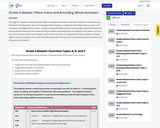
In the first unit of Grade 3, students will build on their understanding of the structure of the place value system from Grade 2 (MP.7), start to use rounding as a way to estimate quantities (3.NBT.1), as well as develop fluency with the standard algorithm of addition and subtraction (3.NBT.2). Throughout the unit, students attend to the precision of their calculations (MP.6) and use them to solve real-world problems (MP.4).
In Grade 2, students developed an understanding of the structure of the base-ten system as based in repeated bundling in groups of 10. With this deepened understanding of the place value system, Grade 2 students “add and subtract within 1000, with composing and decomposing, and they understand and explain the reasoning of the processes they use” (NBT Progressions, p. 8). These processes and strategies include concrete models or drawings and strategies based on place value, properties of operations, and/or the relationship between addition and subtraction (2.NBT.7). As such, at the end of Grade 2, students are able to add and subtract within 1,000 but often aren’t relying on the standard algorithm to solve.
Thus, Unit 1 starts off with reinforcing some of this place value understanding of thousands, hundreds, tens, and ones being made up of 10 of the unit to its right that students learned in Grade 2. Students use this sense of magnitude and the idea of benchmark numbers to first place numbers on number lines of various endpoints and intervals, and next use those number lines as a model to help students round two-digit numbers to the tens place as well as three-digit numbers to the hundreds and tens place (3.NBT.1). Next, students focus on developing their fluency with the addition and subtraction algorithms up to 1,000, making connections to the place value understandings and other models they learned in Grade 2 (3.NBT.2). Last, the unit culminates in a synthesis of all learning thus far in the unit, in which students solve one- and two-step word problems involving addition and subtraction and use rounding to assess the reasonableness of their answer (3.OA.8), connecting the NBT and OA domains. These skills are developed further and built upon in subsequent units in which multiplication and division are added to the types of word problems students estimate and solve.
- Subject:
- Mathematics
- Material Type:
- Assessment
- Homework/Assignment
- Lesson Plan
- Unit of Study
- Provider:
- Match Fishtank
- Date Added:
- 01/01/2017
